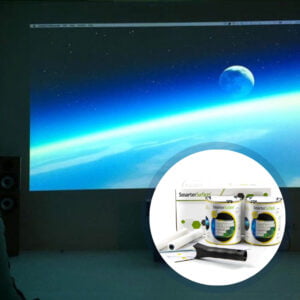Benefits of Using Black Projector Screen Paint
Improved Contrast in Images
Black Projector Screen Paint absorbs ambient light, enhancing image contrast and delivering the best reproduction of darker image portions for improved viewing experiences.Commercial Projection Quality
Designed for projection screens in environments with robust equipment and minimal ambient light, like home theatres, providing the best contrast and visual depth in our product range.Optimal Projection Efficiency
Evaluated using industry-standard projectors to guarantee optimal projection efficiency, addressing issues of hot spots and performance degradation over time.Effortless Application and Polished Finish
Easy and streamlined application for discreet projection abilities preserving a minimalist and elegant aesthetic in home theatres.Ultra Matt Layering Technology
The ultra matt layering technology developed by Smarter Surfaces maximizes pixel definition, enhancing image quality and sharpness.For Use With Black Projector Screen Paint
- Projector Requirements: HD, 4K, and 8K Projector
- Minimum Recommended Lumen Value: 2,500 Lumens
- Lighting: works in very dark rooms
- Compatible Surfaces: can be applied to fabrics and is suitable for painting or refurbishing old screens, but not suitable for roll-up screens.
Black Projector Screen Paint Performance
- 4K & 8K Ultra HD Ready
- Gain Value @ 90 °: 0.20
- Viewing Angle: 140 degrees
- Certification: Independent Projection Performance Report – CREST
Comparison Table
Compare the performance and specifications of our full projection range
Black Projector Screen Paint - Technical Specifications
Color: Black
Finish: Matt
Screen Size:
- 48 ft2 at 16:9 Aspect Ratio
- 270 ft2 at 16:9 Aspect Ratio
Volume:
- 4.5 m2 : 320cm at 16:9 Aspect Ratio
- 25 m2 : 764.5cm at 16:9 Aspect Ratio
Coverage:
- 4.5 m2 : 279 x 157 cm at 16:9 Aspect Ratio
- 25 m2 : 667 x 375 cm at 16:9 Aspect Ratio
Environmental (exceeds all UK standards): low VOC, solvent free, PFOA & PFOS free and isocyanates free
Odour: Very Low
VOC: Less than 0.13%
Certification: Independent Projection Performance Report – CREST, Gypsum Surface Finish Quality Standard of UK Level Q4
Not certain which product is best for you? We assist with video calls, live chat, phone, and email. Take advantage of complimentary technical guidance and ideas for product suggestions so you can select what suits you best. Are you confused about installation? We're here to assist and guide you.
Kit Contents 4.5 m2
- Smart Black Projector Screen Paint
- Roller Handle
- Roller Sleeve
- Stirring Stick
- Application Guide
Kit Contents 25 m2
- Smart Black Projector Screen Paint
- Application Guide
Black Projector Screen Paint Reviews
Joy Gallaher
Dinesh Kanal
Gaël Masad
You may also like…
Ambient Light Rejecting Projector Screen Paint
From £171.00 ex.VAT Select options This product has multiple variants. The options may be chosen on the product pageClear Projector Screen Paint
From £163.00 ex.VAT Select options This product has multiple variants. The options may be chosen on the product pageHigh Contrast Projector Screen Paint
From £180.00 ex.VAT Select options This product has multiple variants. The options may be chosen on the product pageSmart Ultra High Contrast Projector Screen Paint
From £188.00 ex.VAT Select options This product has multiple variants. The options may be chosen on the product page
FAQ's
They are suitable for use on plaster, wall boards, wood, metal or any smooth surface.
The gain value signifies the amount of lumens that the screen can reflect. A higher gain value means that more light is reflected, producing a brighter image on the screen. In contrast, a lower gain value results in reduced light reflection and a dimmer image.
The gain value also affects the viewing angle. A screen with a high gain will have a narrower viewing angle, requiring viewers to be positioned more directly in front of it to enjoy optimal brightness. Conversely, a screen with a lower gain will provide a wider viewing angle, allowing viewers to see a brighter image even from off-centre positions.
It's essential to understand that the selection of gain is influenced by the viewing environment and the desired experience. Elements such as ambient lighting, screen dimensions, projector brightness, and the arrangement of seating in the audience are all critical factors in determining the best gain for a particular scenario.
Successfully blending projections needs accurate colour reproduction, consistent brightness, and superior light diffusion to ensure a smooth transition between the images being projected. Our black projection paint has been developed with all of these factors in mind, enabling you to create a unified and immersive display.
For larger screens, our projection screen paint removes the necessity for bulky and costly physical screens, offering a more adaptable and economical solution for blending projections. You can turn any area into an immersive canvas where various projections blend seamlessly, engaging your audience.
The SAC can differ depending on the frequency of the sound waves that pass through the material. Various sound wave frequencies come with distinct wavelengths, and these wavelengths can interact with the material in multiple ways. Consequently, the SAC values provided represent a range, as the SAC will fluctuate based on the frequencies of the absorbed sound waves. In our tests, we recorded the following data:
Unpainted Board α = 0.04-0.07
Painted Board α = 0.04-0.07
The values listed correspond to a 12mm gypsum board that is unpainted and another that is painted. The α values of 0.04-0.07 for both boards indicate a range of SAC values for these materials. It means that when sound waves interact with a 12mm gypsum board, some sound energy will be absorbed by the material, with the amount of absorption falling within the range of 0.04-0.07 depending on the frequency of the sound waves. Furthermore, it also shows that all our paints possess acoustic transparency as there is no difference in performance between the standard board and its painted version.
Black Projector Screen Paint complies with the highest environmental standards and has been certified for both fire performance and VOC content. We recommend using the gloves included in the kit while applying the paint. As with any paint, wearing gloves during application is advisable.
Black Projector Screen Paint Installation
Black Projector Screen Paint can be applied to surfaces such as wallboards, wood, metal, plaster, concrete, and composites. It is intended for indoor use only.
Ensure that all areas to be painted are clean, dry, and devoid of loose materials. Measure the painting area and clearly outline it with masking tape.
For bare or untreated surfaces, apply one coat of White Primer. After priming, lightly sand the surface, and then use a mohair or lint-free short pile roller sleeve for the first coat. Permit it to dry before applying the second coat.
Our Black Projector Screen Paint is ready for use after 24 hours.
If you want to assess our product's performance, feel free to request a sample pack.
If you have any questions or need assistance, we are dedicated to providing excellent customer service and support. Just reach out to us.
![]() A full application guide to help you apply our Black Projector Screen Paint.
A full application guide to help you apply our Black Projector Screen Paint.
Black Projector Screen Paint installation Video
Watch our step-by-step Video Application Guide
Black Projector Screen Paint Videos
Watch our step-by-step Video Application Guide
Whiteboard Paint White for Education
Whiteboard Paint White Case Study














